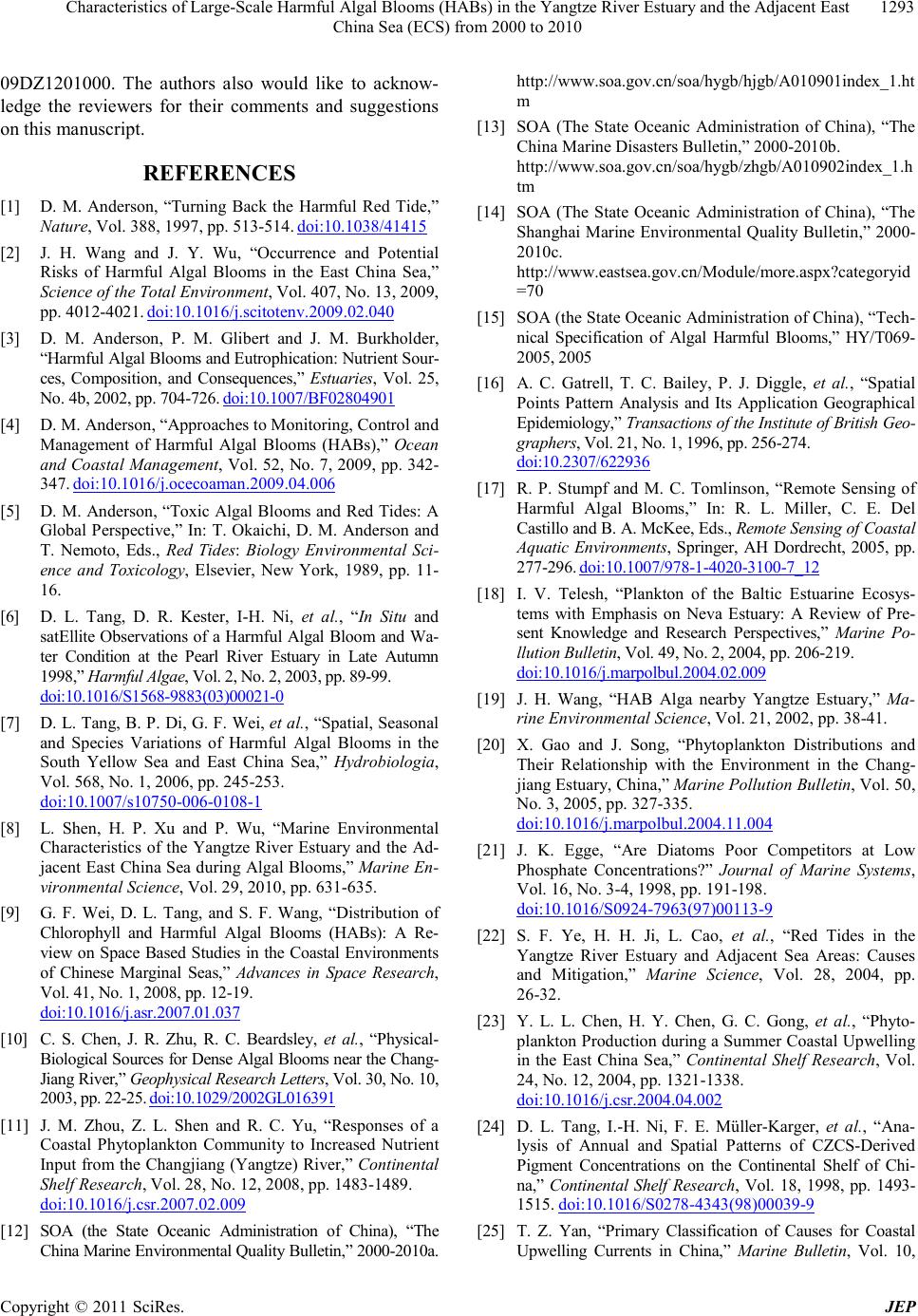
Characteristi cs of Large-Scale Harmful Algal Blooms (HABs) in t he Yangtze River Estuary and th e Adjacent E ast 1293
China Sea (ECS) from 2000 to 2010
09DZ1201000. The authors also would like to acknow-
ledge the reviewers for their comments and suggestions
on this manuscript.
REFERENCES
[1] D. M. Anderson, “Turning Back the Harmful Red Tide,”
Nature, Vol. 388, 1997, pp. 513-514. doi:10.1038/41415
[2] J. H. Wang and J. Y. Wu, “Occurrence and Potential
Risks of Harmful Algal Blooms in the East China Sea,”
Science of the Tota l Environ ment, Vol. 407, No. 13, 2009,
pp. 4012 -4021. doi:10.1016/j.scitotenv.2009.02.040
[3] D. M. Anderson, P. M. Glibert and J. M. Burkholder,
“Harmful Algal Blooms and Eutrophication: Nutrient Sour-
ces, Composition, and Consequences,” Estuaries, Vol. 25,
No. 4b, 2002, pp. 704- 7 26. doi:10.1007/BF02804901
[4] D. M. Anderson, “Approaches to Monitoring, Control and
Management of Harmful Algal Blooms (HABs),” Ocean
and Coastal Management, Vol. 52, No. 7, 2009 , pp. 342-
347. doi :10.1016 /j.ocecoaman.2009.04.006
[5] D. M. Anderson, “Toxic Algal Blooms and Red Tides: A
Global Perspective,” In: T. Okaichi, D. M. Anderson and
T. Nemoto, Eds., Red Tides: Biology Environmental Sci-
ence and Toxicology, Elsevier, New York, 1989, pp. 11-
16.
[6] D. L. Tang, D. R. Kester, I-H. Ni, et al., “In Situ and
satEllite Observations of a Harmful Algal Bloom and Wa-
ter Condition at the Pearl River Estuary in Late Autumn
1998,” Harmful Algae, Vol. 2, No. 2, 2003, pp. 89-99.
doi:10.1016/S1568-9883(03)00021-0
[7] D. L. Tang, B. P. Di, G. F. Wei, et al ., “Spatial, Seasonal
and Species Variations of Harmful Algal Blooms in the
South Yellow Sea and East China Sea,” Hydrobiologia,
Vol. 568, No. 1, 2006, pp. 245-253.
do i:10.1007/s10750-006-0108-1
[8] L. Shen, H. P. Xu and P. Wu, “Marine Environmental
Characteristics of the Yangtze River Estuary and the Ad-
jacent East China Sea d uring Algal Blo oms,” Marine E n-
vironmental Science, Vol. 29, 2010, pp. 631-635.
[9] G. F. Wei, D. L. Tang, and S. F. Wang, “Distribution of
Chlorophyll and Harmful Algal Blooms (HABs): A Re-
view on Space Based Studies in the Coastal Environments
of Chinese Marginal Seas,” Advances in Space Research,
Vol. 41, No. 1, 2008, pp. 12-19.
doi:10.1016/j.asr.2007.01.037
[10] C. S. Chen, J. R. Zhu, R. C. Beardsley, et al., “Physical-
Biological Sources for Dense Algal Blooms near the Chang-
Jian g River,” Geophysical Research Letters, Vol. 30, No. 10,
2003, pp. 22-25. doi:10.1029/2002GL016391
[11] J. M. Zhou, Z. L. Shen and R. C. Yu, “Responses of a
Coastal Phytoplankton Community to Increased Nutrient
Input from the Ch angjiang (Yangtze) River,” Continental
Shelf Research, Vol. 28, No. 12, 2008, pp. 1483-1489.
do i:10.1016/ j.csr.2007.02.009
[12] SOA (the State Oceanic Administration of China), “The
China Marine Environmental Quality Bulletin,” 2000-2010a.
http://www.soa.gov.cn/soa/hygb/hjgb/A010901index_1.ht
m
[13] SOA (The State Oceanic Administration of China), “The
China Marine Disasters Bulletin,” 2000-2010b.
http://www.soa.gov.cn/soa/hygb/zhgb/A010902index_1.h
tm
[14] SOA (The State Oceanic Administration of China), “The
Shanghai Marine Environmental Quality Bulletin,” 2000-
2010c.
http://www.eastsea.gov.cn/Module/more.aspx?categoryid
=70
[15] SOA (the State Oceanic Administration of China), “Tech-
nical Specification of Algal Harmful Blooms,” HY/T069-
2005, 2005
[16] A. C. Gatrell, T. C. Bailey, P. J. Diggle, et al., “Spatial
Points Pattern Analysis and Its Application Geographical
Epidemiolog y,” Transactions of the Institute of British Geo-
graphers, Vol. 21, No. 1, 1996, pp. 256-274.
doi:10.2307/622936
[17] R. P. Stumpf and M. C. Tomlinson, “Remote Sensing of
Harmful Algal Blooms,” In: R. L. Miller, C. E. Del
Castillo and B. A. McKee, Eds., Remote Sensing of Coastal
Aquatic Environments, Springer, AH Dordrecht, 2005, pp.
277-296. doi:10.1007/978-1-4020-3100-7_12
[18] I. V. Telesh, “Plankton of the Baltic Estuarine Ecosys-
tems with Emphasis on Neva Estuary: A Review of Pre-
sent Knowledge and Research Perspectives,” Marine Po-
llution Bulletin, Vol . 49, No. 2, 20 04, pp . 20 6- 21 9.
doi:10.1016/j.marpolbul.2004.02.009
[19] J. H. Wang, “HAB Alga nearby Yangtze Estuary,” Ma-
rine Environmental Science, Vol. 21, 2002, pp. 38-41 .
[20] X. Gao and J. Song, “Phytoplankton Distributions and
Their Relationship with the Environment in the Chang-
jiang Estuary, China,” Marine Pollution Bulletin, Vol. 50,
No. 3, 2005, pp. 327-335.
doi:10.1016/j.marpolbul.2004.11.004
[21] J. K. Egge, “Are Diatoms Poor Competitors at Low
Phosphate Concentrations?” Journal of Marine Systems,
Vol. 16, No. 3-4, 1998, pp. 191-198.
doi:10.1016/S0924-7963(97)00113-9
[22] S. F. Ye, H. H. Ji, L. Cao, et al., “Red Tides in the
Yangtze River Estuary and Adjacent Sea Areas: Causes
and Mitigation,” Marine Science, Vol. 28, 2004, pp.
26-32.
[23] Y. L. L. Chen, H. Y. Chen, G. C. Gong, et al., “Phyto-
plankton Production during a Summer Coastal Upwelling
in the East China Sea,” Continental Shelf Research, Vol.
24, No. 12, 2004, pp. 1321-1338.
do i:10.1016/ j.csr.2004.04.002
[24] D. L. Tang, I.-H. Ni, F. E. Müller-Karger, et al., “Ana-
lysis of Annual and Spatial Patterns of CZCS-Derived
Pigment Concentrations on the Continental Shelf of Chi-
na,” Continental Shelf Research, Vol. 18, 1998, pp. 1493-
1515. doi:10.1016/S0278-4343(98)00039-9
[25] T. Z. Yan, “Primary Classification of Causes for Coastal
Upwelling Currents in China,” Marine Bulletin, Vol. 10,
Copyright © 2011 SciRes. JEP